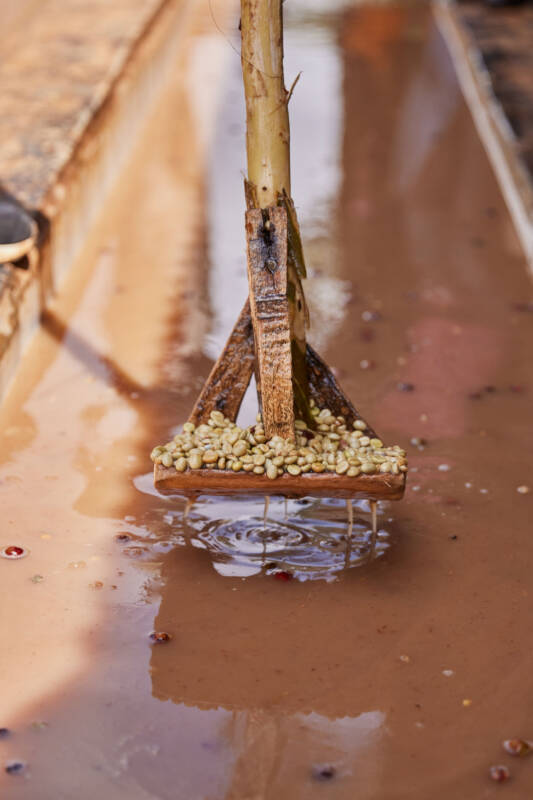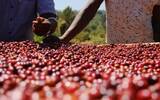What is the difference between double washing, K72, dry fermentation washing and ordinary washing?

Water washing is one of the most traditional and common ways to treat raw coffee beans. The process of shelling and washing not only greatly improves the production quality, but also gives the coffee in the cup a good cleanliness. It has become a favorite form of raw bean processing for countless coffee lovers, including Qianjie, of course.
With the gradual popularization of boutique coffee, more and more consumers begin to pay attention to the traceability information of individual coffee, so in order to highlight some selling points, many producers add prefix modifiers to the names of the treatments. such as "double washing", "K72 washing", "dry fermentation washing" and so on, so how are they different from conventional washing?
Before learning about these "new" treatments, Qianjie thinks it is necessary to give you a clear picture of the origin of traditional washing.
Washing method
Also known as wet treatment, translated from "Wet Process", is a method of processing and obtaining raw beans by removing exocarp and pectin before the seeds are dried.
According to the relevant information read on Qianjie, this method of wet treatment began in the West Indies in the 19th century and was developed in Jamaica. At that time, it was called WIP (West Indies treatment), which was mainly suitable for wet and rainy areas. The counterpart is OIB (Oost Indische Bereiding, East Indies treatment), which refers to the traditional sun exposure.
Before the 1850s, people used the oldest natural sun to treat coffee fruit. With the advent of the industrial revolution, this "peeling first" coffee processing technology came into being. In the mid-19th century, Jamaica became one of the largest coffee producers in the world, producing about 70,000 tons of raw beans a year. Because the land here is an island climate, the fruit is not easy to dry, so it is not very advantageous for the natural sun to be applied on this land.
In 1845, the invention of the world's first coffee peeling machine (coffee pulper machine) was patented by James Meacock from Kingston, Jamaica, a machine for peeling coffee fruits and screening coffee. In this way, more and more inventions related to coffee peeling machine have been born, and the washing method has been formally applied to coffee production.
The process of traditional wet treatment is not complicated: flotation → peeling, → fermentation, → washing, → drying, → shelling, → packaging, but its implementation requires adequate water supply, and because it is very dependent on the assistance of equipment, so the producers of washing should have sufficient funds to invest in the purchase of equipment. The rise of the washing method coincided with the early American plantations built by capital, that is, having sufficient operating funds, coupled with the invention of various pulpers / shellers born to meet the needs of the times. this has led to the widespread spread of water washing throughout the Americas.
Double washing
The original wet treatment method is to wash the fermented coffee beans with clean water, wash off the pectin, and then transport it directly to the drying ground to dry and pack. But in Kenya, a round of washed coffee will be re-soaked in a pool of clean water, then picked up and washed again before being sent to the sun farm for dehydration.

The reason why Kenya changed the conventional washing to "secondary immersion" at first was not in pursuit of flavor, but because the local drying grounds were not enough. Kenya is a typical cooperative operation model in Africa. Every harvest season, small farmers will send the fresh fruit to the processing plant all day. The process of peeling and fermentation is relatively simple and does not take time, but it takes at least 5 to 7 days to dry each batch of fermented beans. Sometimes if the amount of processing is too large, there will be no place for the washed beans to dry. So people have to pour the wet beans back into the pool and let them "cool" to avoid damage or pollution until the drying field is empty.
This form of secondary bubble washing is called "Double Washed", that is, double washing, and there are also "Fully Washed", "Double Fermentation" and other names in the producing area, that is, complete washing. Because Kenya is the region where this treatment was first popular, this kind of washing is also known as "Kenyan Process", the Kenyan method of treatment. Later, it was found that the water-washed beans, which were fermented twice according to local conditions, were not only conducive to stable quality control in production, but also brought rich fruity flavor to the coffee. Today, some American estates also use this Kenyan style to wash their coffee.
K72 washing method
The 72-hour washing method in Kenya can be understood as an additional extension of ordinary washing and double washing.
This kind of washing process pays attention to the control of fermentation time, which first carries out 24 hours of washing and fermentation, then cleans up the fallen pectin, ferments for another 24 hours in a clean pool, and then cleans up the residual ingredients again. It is introduced into the tank with clean water for fermentation for the last 24 hours, a total of 72 hours. This process also gives Kenyan coffee bright and clean high-quality acidity, which is used by Asalia, a daily product on Qianjie Street, to make the coffee as sour as a baby tomato and a black plum.
Dry fermentation (water washing) method
As the initial wet treatment requires the use of a large amount of pure water, the waste water after fermentation has been acidified, and discharge into the river or soil will have an impact on the ecological environment, so in order to respond to environmental protection and save water resources, more water-saving dry fermentation washing method has been advocated by people.
The so-called "dry fermentation" means that after the peel is removed, the shell beans are poured directly into the fermentation tank for about 6-8 hours. This step is actually very similar to the honey treatment that we are more familiar with. The difference is that dry-fermented coffee also needs to be washed with water to completely remove the degraded sticky material. In terms of flavor, regular washing tends to have a brighter taste, and dry-fermented washed coffee usually has a more round sweetness than wet treatment (because it is similar to honey treatment).
It is not difficult to find that fermentation is a necessary link in washing treatment, so no matter which kind of washing method it is, it is nothing more than the difference in the length and frequency of soaking water during fermentation, high or low temperature, aerobic or anaerobic, and whether there are other additives and so on.
-END-
Front Street Cafe
No. 10 Baoqian street, Yandun road, Dongshankou, Yuexiu district, Guangzhou, Guangdong province
Important Notice :
前街咖啡 FrontStreet Coffee has moved to new addredd:
FrontStreet Coffee Address: 315,Donghua East Road,GuangZhou
Tel:020 38364473
- Prev

Ethiopian Coffee Bean | introduction to Huakui 7.0 of Humbera Buku Abel processing Plant in Guji production area
When it comes to coffee, many people think of Ethiopia, after all, Ethiopia is recognized as the birthplace of coffee. Ethiopia has a long history of coffee, and Ethiopia is the world's largest coffee gene pool, with a wide variety of coffee. It is estimated that there are 10000 to 15000 species in Ethiopia today.
- Next

How much difference does the same bean, ear bag and hand punch have?
With the popularity of coffee culture in China, more and more professionals choose to enjoy a cup of coffee before going to work to refresh themselves, which has become their daily drink, and many people are equipped with various production utensils at home. However, due to the relatively cumbersome process of making hand-brewed coffee, many people prefer to choose a more cost-effective one.
Related
- What effect does Italian American coffee with filter paper have? Will coffee taste better if it is put on filter paper at the bottom of the powder bowl?
- What is the color difference in coffee beans? What are the characteristics of honey processed coffee beans? Why are the anaerobically treated coffee beans uneven in color?
- How does novice Xiaobai quickly get started and make coffee? Newbies learn to make coffee by hand and share the specific steps and process process!
- Costa tea has a shelf life of 100 years?! Expert: Unable to verify
- It's a huge uproar! American milk addition was rejected by Manner employees?!
- Mocha pot coffee bean recommendations| How fine and how much powder should be used for grinding? What parameter ratios do I need to use to make milk with Mocha pot coffee?
- What are the characteristics of the world's top ten coffee beans treated with Costa Rica honey? How to make black honey kadura from Tarazhu Pilon Processing Plant taste good?
- How to make deep-roasted coffee? What grinding water temperature does authentic Jamaica Blue Mountain No. 1 coffee use to brew it well?
- Selected high-grade rose summer coffee flavor tasting guide Why Panama rose summer has the aroma of flowers and fruits
- What equipment does a novice Xiaobai need to buy to learn to make coffee? Filter cup electronic scale bean grinder manual flushing pot purchase guide

